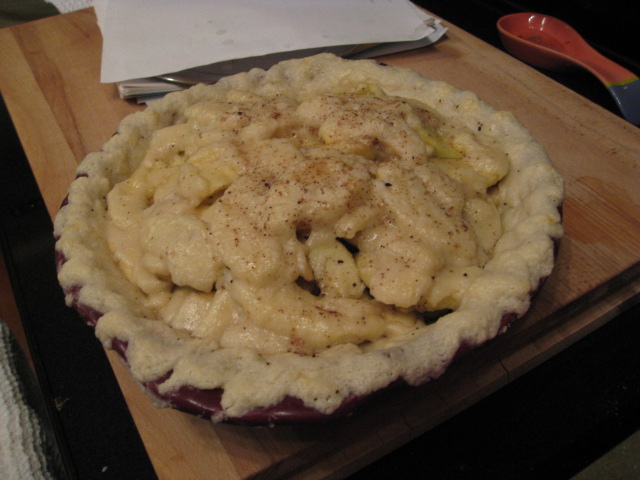Posts from February 2008
The Mystery of the Melting Pie - Solved!
To quote Stephen Colbert, I Did It!
Oh yeah, I kinda went crazy. Two apple pies and two dozen butter tarts (using Linda’s delicious recipe… and boy, did they turn out fine). So, what happened? Well, allow me to ramble:
First off, understand that one of the reasons we make products with flour, and coincidentally one of the reasons celiacs hate it so much, is because of our good friend, gluten. Gluten is a protein present in wheat flour (and I’m assuming other grain flours, as well), and it is gluten which gives flour-based doughs their structure. Basically, when you introduce water to flour and start kneeding it, you liberate the gluten, which proceeds to create a little microscope network of protein strands. The result is a dough which is stretchy and, when baked, chewy (and delicious). Add yeast, baking soda, or some other leavening agent, and you get lift, as the gluten allows bubbles of carbon dioxide and steam to form in the dough.
But in the world of pastry, gluten is, generally speaking, your enemy. Gluten formation produces a pastry crust that’s chewy and tough, instead of flakey and light. As such, we do all sorts of things to discourage gluten development in pastry dough:
- Add only the minimal water necessary to bring the dough together.
- Avoid kneeding at all costs.
- Use a low-gluten pastry flour.
And it is that last item that was the key. In the world of flour, there’s all sorts of grades, separated by the amount of gluten present. Lowest to highest, we have:
- Cake flour
- Pastry flour
- All-purpose flour
- Bread flour
I’m sure there’s others in and around those, but those are the most common. Well, I went and bought a flour labelled “Cake and Pastry” flour. But which is it? Well, it turns out it’s the first (real pastry flour is actually pretty hard to come by in regular grocery stores). And there lies the key.
You know how I said gluten was a pastry-maker’s enemy? Well, that was a bit of a lie. You do need some gluten, otherwise those lovely, flakey layers can’t form. And more importantly, without gluten, the only thing holding the dough together is… the fat. And guess what? Fat melts in the oven. So a pastry dough with extremely low gluten levels will do just that: fall apart when the fat melts. Dough! (yes, that was a pun. Suck it up).
The solution? Well, I didn’t have all-purpose flour on-hand, so I used a 50% blend of cake and bread flour. Voila! Crust that held together (and tasted yummy!) So, remember, when making pastry, gluten is bad! Mostly.
The Spectacular Pie Failure
Well, it had to happen eventually. For the first time ever, in the history of my pie baking experience, I had a complete, utter, total, truly spectacular pie failure. Well, they say a picture says a thousand words:
Frankly, I’m at a loss for words. Obviously, I pulled it out well before it was “done”. But it’s clear the crust simply melted in the oven… honestly, I’ve never seen anything like it.
Now I’m trying to figure out what I did wrong, and while it’s very possible I just measured the fat wrong, I’m actually wondering if it was how I decided to use the food processor this time ‘round. In the past, I’ve just used it to cut the fat into the dough, and it’s worked quite well for that purpose. But this time, I decided to add the water to the dough and bring it together in the processor, as well. As a result, my only guess is that the result was the fat getting over-processed into the dough
But the real killer is I spent, literally, two or three hours last night preparing dough, and then another hour and a half peeling and slicing apples today, and that doesn’t count all the rolling effort and so forth. Am I choked? Yeah… just a little. And I’ll be damned if I’m gonna bake another pie any time soon…

